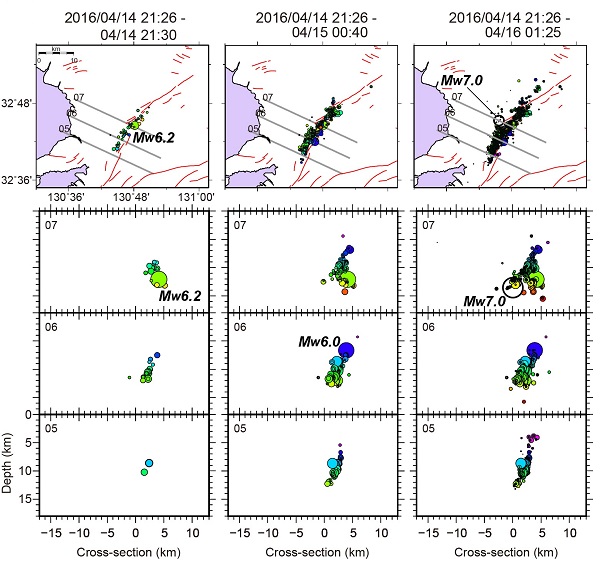Foreshock migration preceded main Kumamoto earthquake in 2016 Slow slip spreads toward the main quake’s fault


Foreshock migration during the 2016 Kumamoto earthquakes
These diagrams (created through data integration) depict the evolution of seismic activity from the time of onset of the foreshocks to the period just before the main shock. They show migration occurred on the fault plane’s dip (shallow and deep ends) and along the fault’s strike.
© 2016 Aitaro Kato.
A research group at the University of Tokyo found that the swarm of smaller quakes that acted as a precursor to the main Kumamoto earthquake in 2016 migrated in parallel and perpendicular directions—along the fault-strike and dip, respectively—to the main quake’s fault plane. The finding points out the foreshocks’ effect on the earthquake’s force and suggests the propagation of slow slip movements toward the main shock’s breaking point ultimately set it off.
A series of earthquakes struck the Kumamoto area in the southwestern Japanese island of Kyushu in April 2016. The main shock, defined as the largest quake, which struck on April 16, was a magnitude 7.0 earthquake. It was reported that this was preceded by a magnitude 6.2 foreshock on April 14 through routine observations made by the Japan Meteorological Agency, but details of the seismic events—related to both space and time, and in terms of stress interactions—leading to the main shock had not been fully understood.
The research group led by Associate Professor Aitaro Kato at the University of Tokyo’s Earthquake Research Institute compiled a hypocenter catalog containing highly accurate assessments of the series of seismic activities related to the foreshocks and main shock of the 2016 Kumamoto earthquake, and analyzed in detail changes in the spatiotemporal evolution of earthquakes over time. When the seismologists examined the earthquake catalog, they saw that after the magnitude 6.2 foreshock on April 14, the earthquakes migrated gradually over time.
The migration occurred both parallel to the fault-strike and along the slope of the dip (the upper end being close to the ground and the lower end deeper down), with indication of movement toward the rupture point of the April 16 main shock. Changes in the movement of the Earth’s crust detected by control stations, operated by the Geospatial Information Authority of Japan, situated close to where the foreshocks struck, have in fact indicated gradual movement in the same direction as the large foreshock rupture in the span of time between the magnitude 6.2 foreshock and the main shock.
Such changes were observed at only a few points, and accurately assessing the location and scale of the slip is quite difficult; however, the observed data supports the view that the slip occurred along the foreshocks’ fault plane, increasing the possibility that the slow slip actually occurred there. This suggests that the slow slip movement together with changes in stress brought on by the foreshocks added force to the main shock’s fault plane, causing it to rupture and bring on the earthquake.
It should be mentioned, though, that with the type of information observed in the current study on the migration of earthquakes and the slow slip, we have not yet reached the point where experts can accurately assess whether or not a big earthquake will strike anytime soon. Whether the fault plane of the main quake ultimately ruptures depends on how much stress has accumulated in areas around the main shock’s center. Moving forward, developing methods for assessing such degree of criticality in faults will become important for seismologic research.
“Similar migration of foreshocks over an extended area in subduction zones, the boundaries where oceanic plates are thrust under the continental plates, has been reported in the past,” says Kato. He continues, “The main finding in the current study is that such phenomena also occur, albeit on a small scale, at active faults situated inland.”
Paper
, "Foreshock migration preceding the 2016 Mw 7.0 Kumamoto earthquake, Japan", Geophysical Research Letters Online Edition: 2016/08/16 (Japan time), doi: 10.1002/2016GL070079.
Article link (Publication)
Links
Department of Earth and Planetary Science, Graduate School of Science







